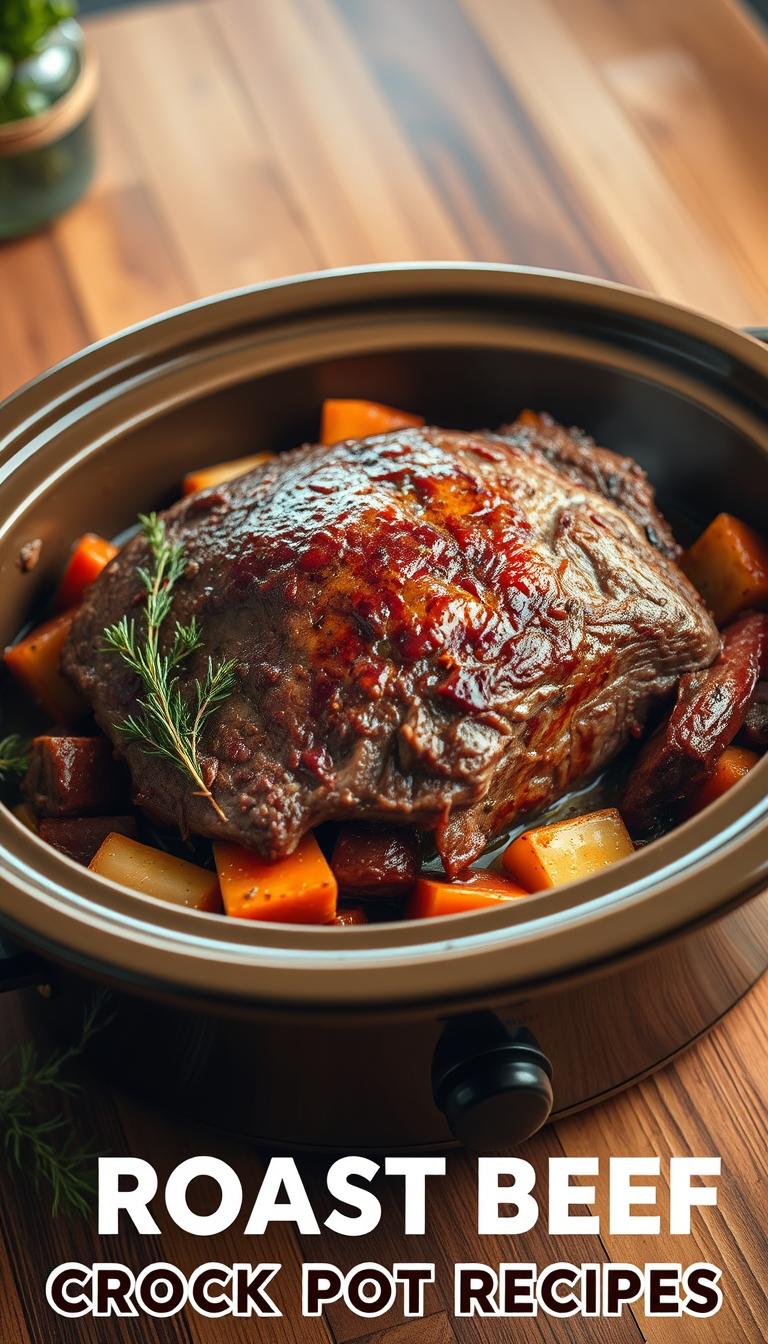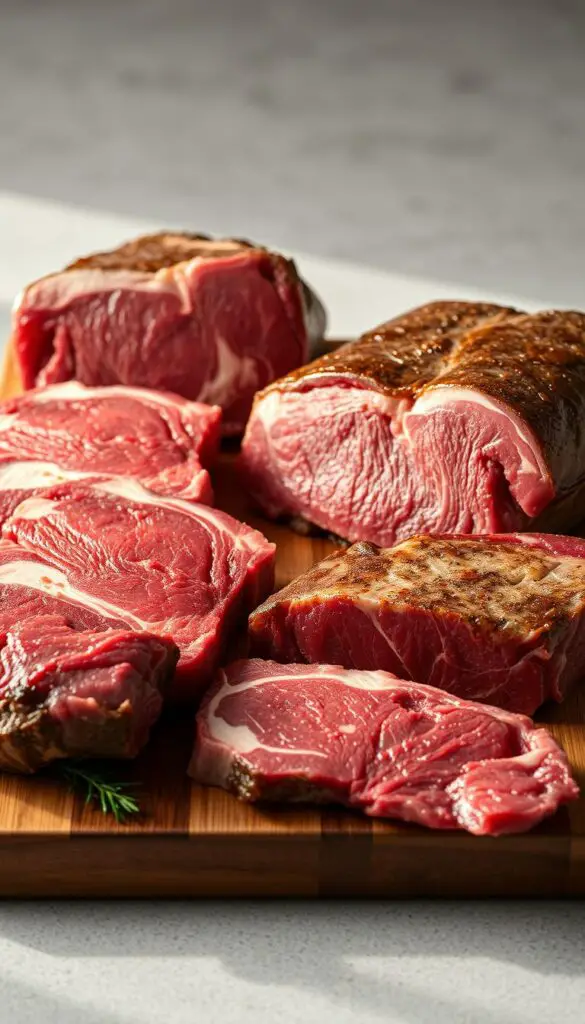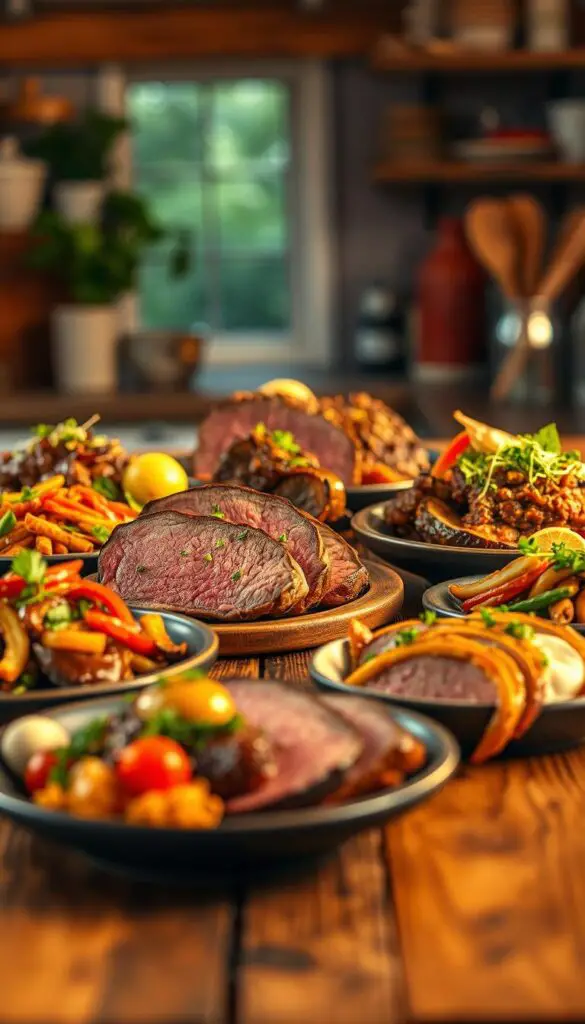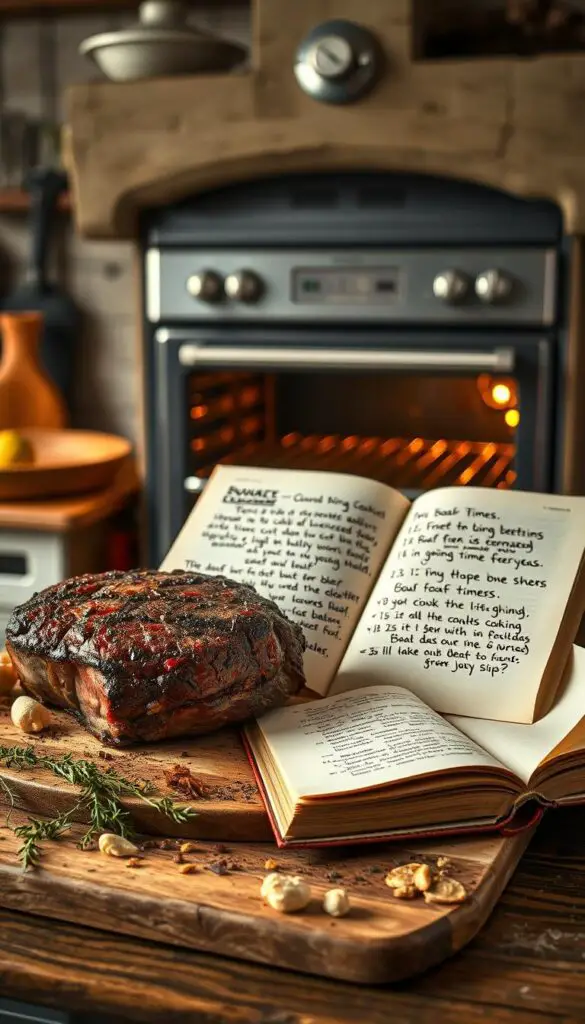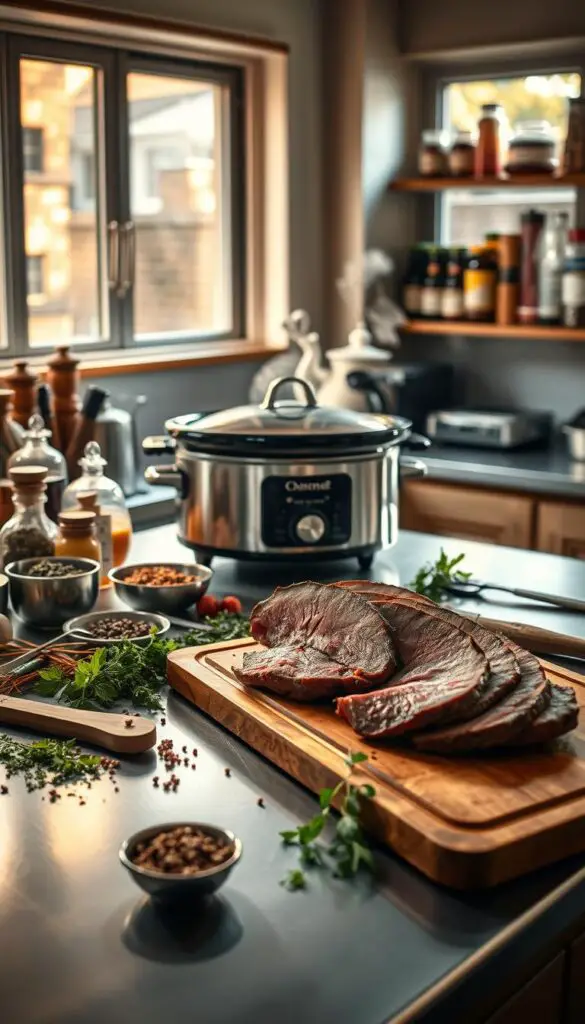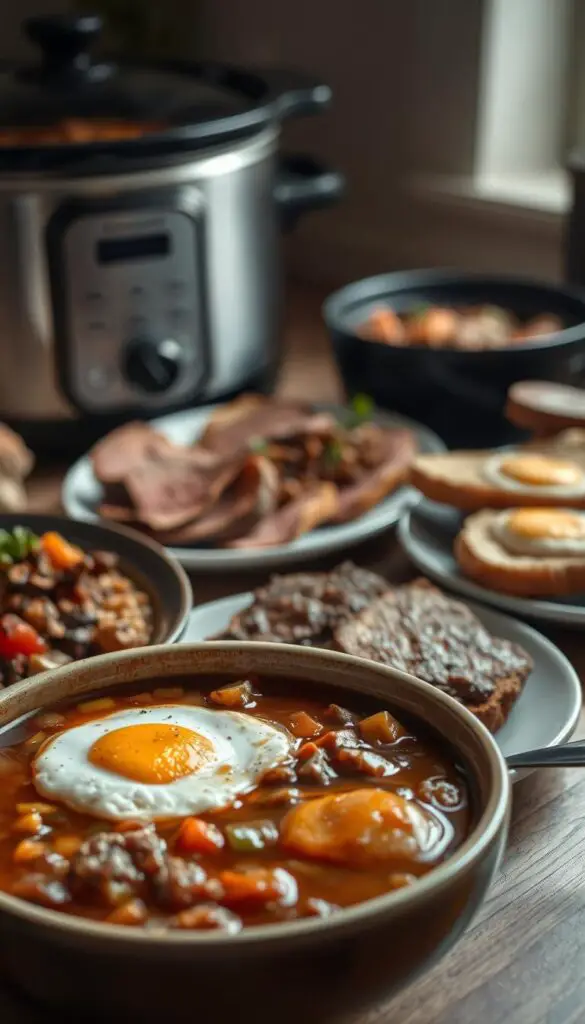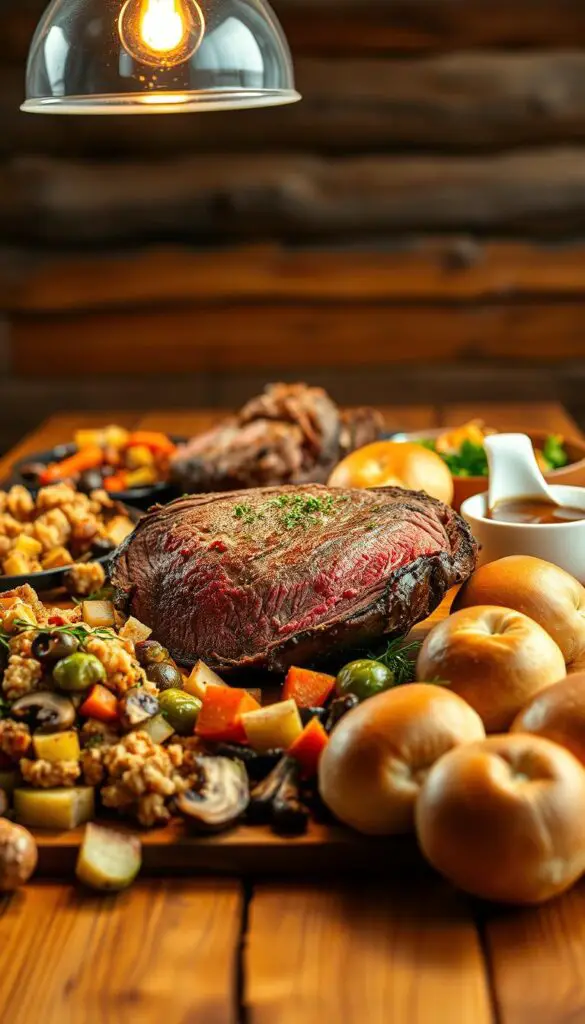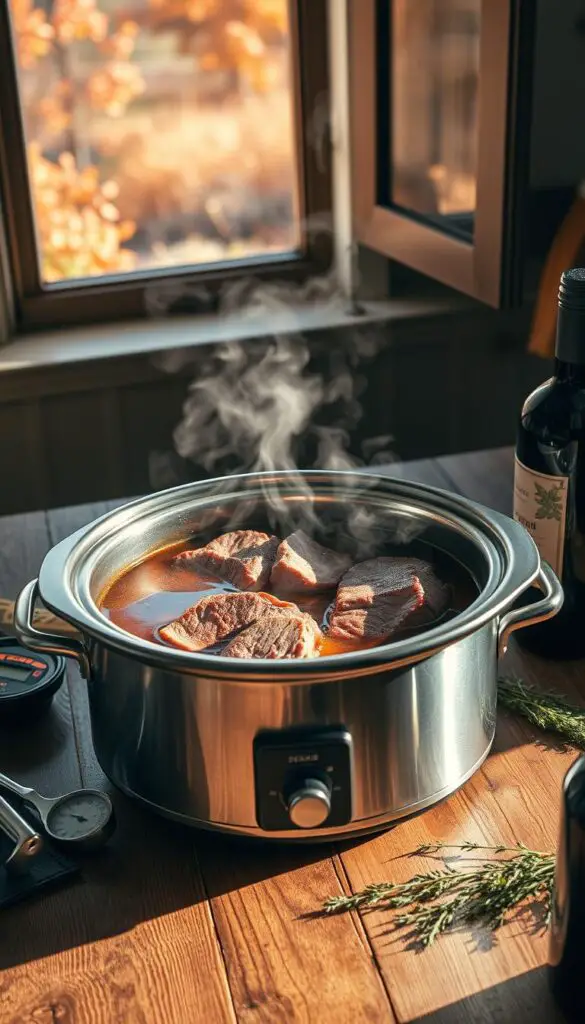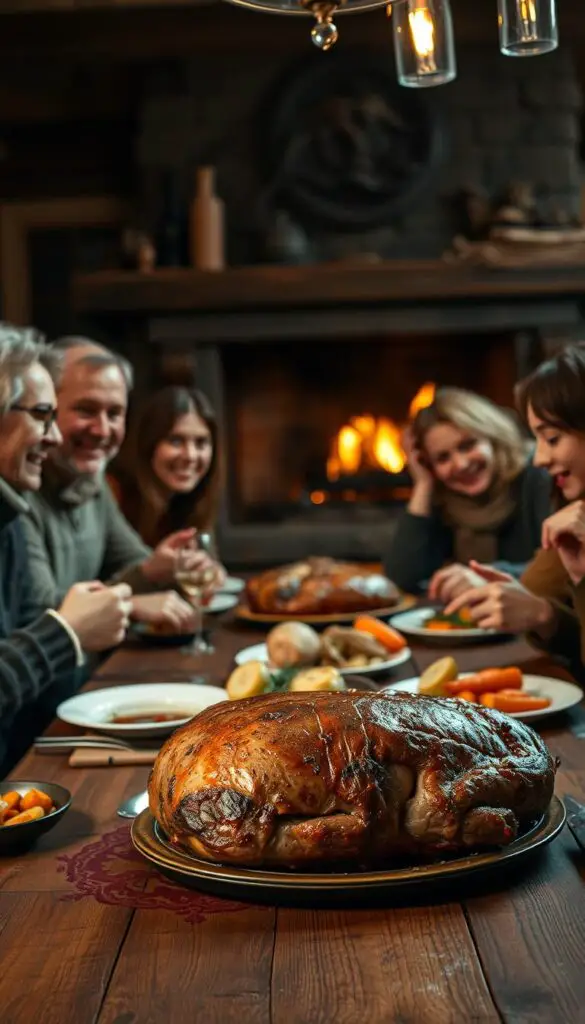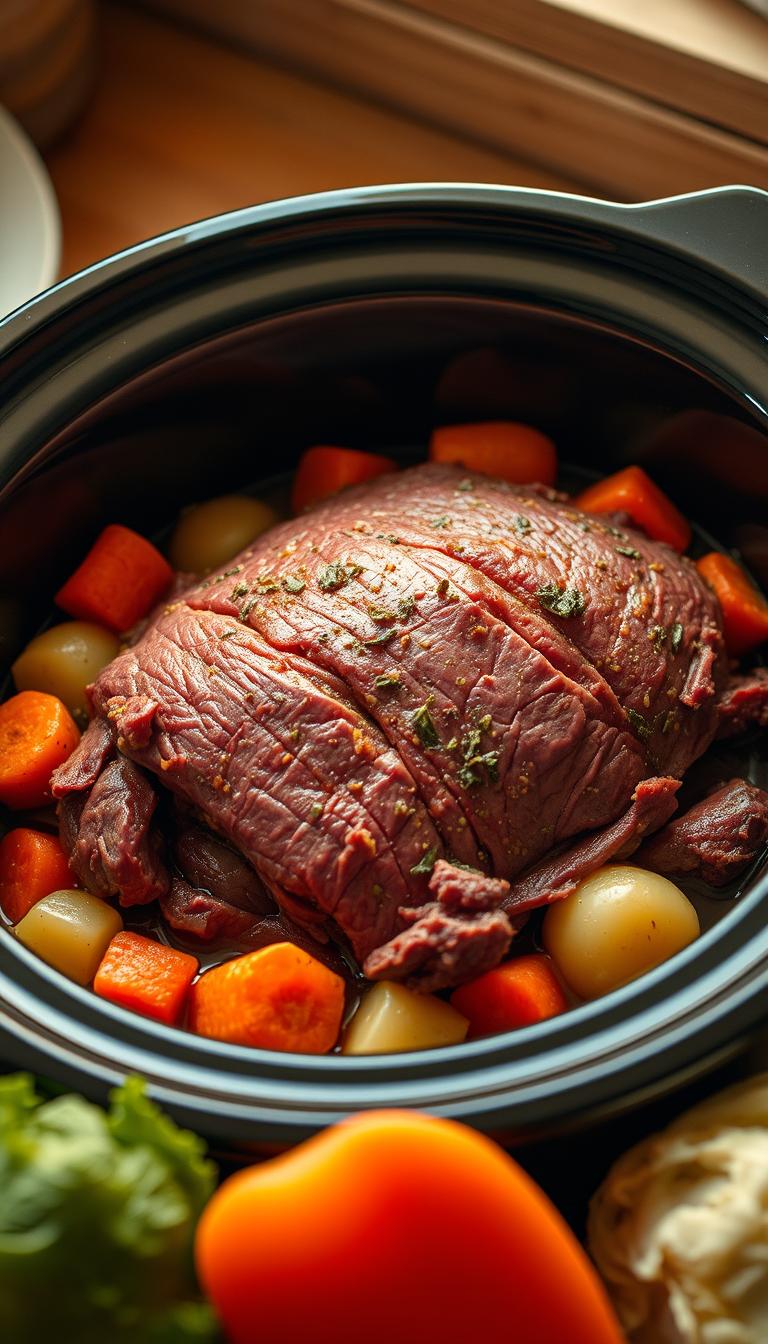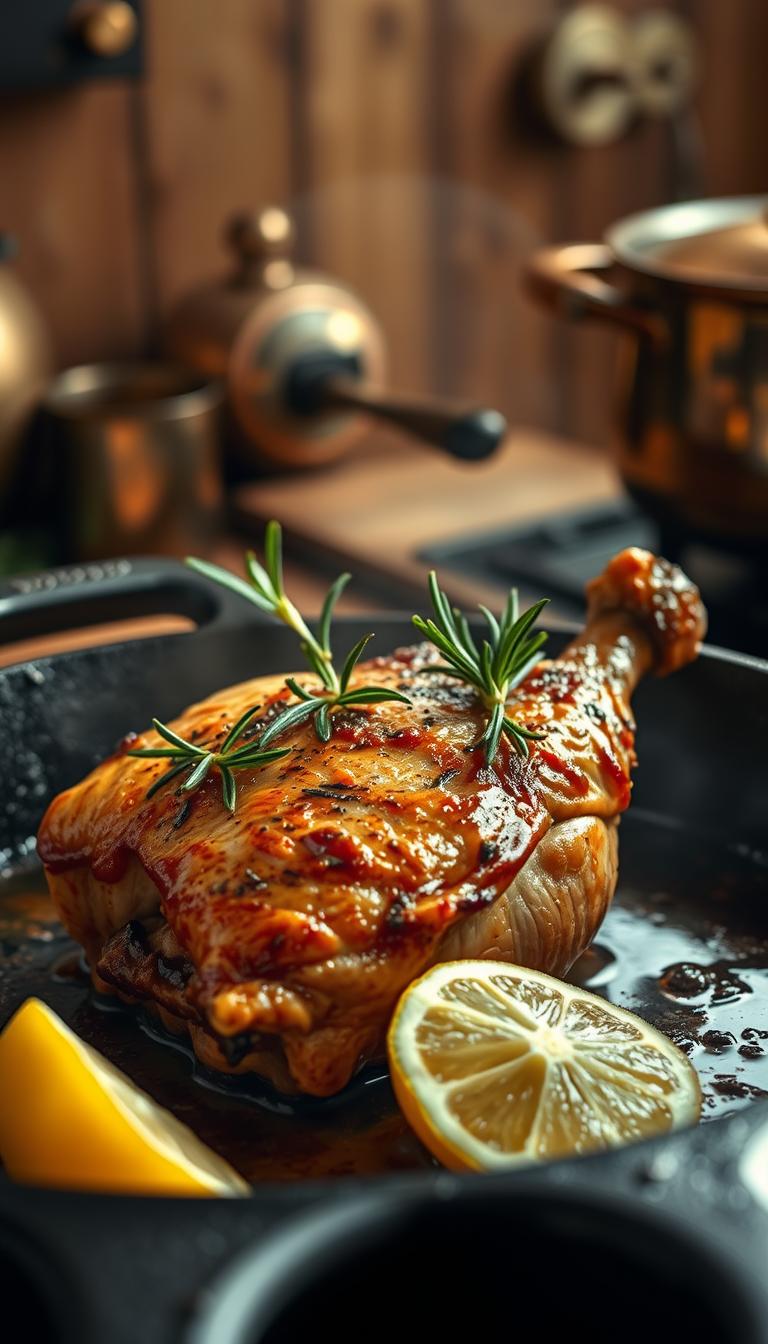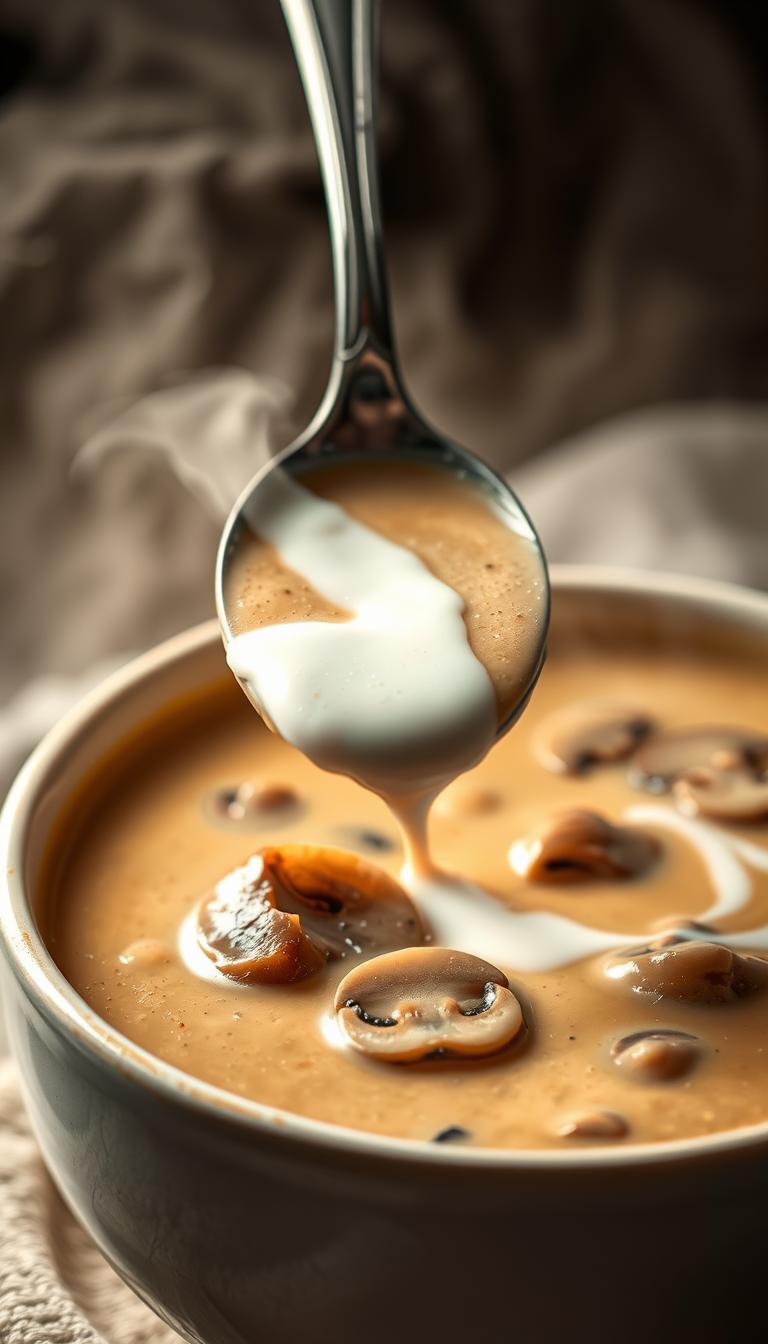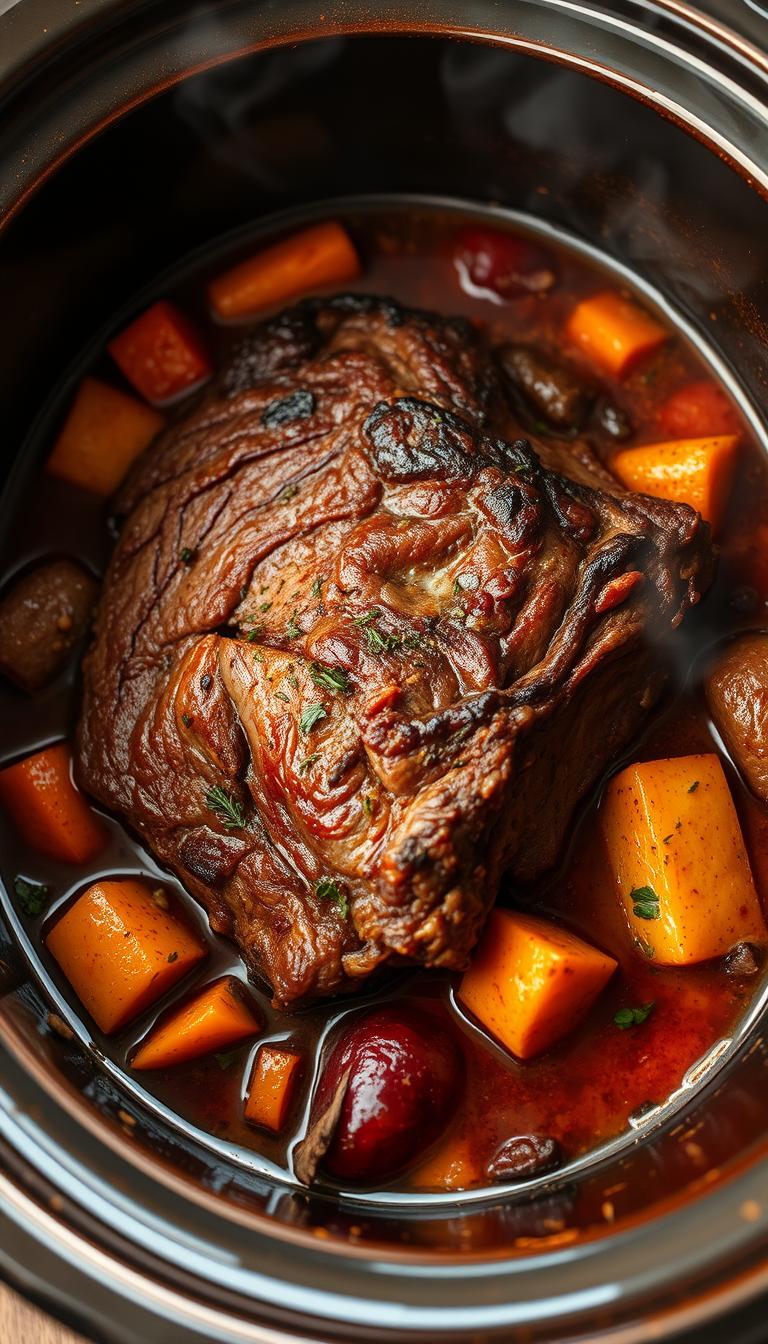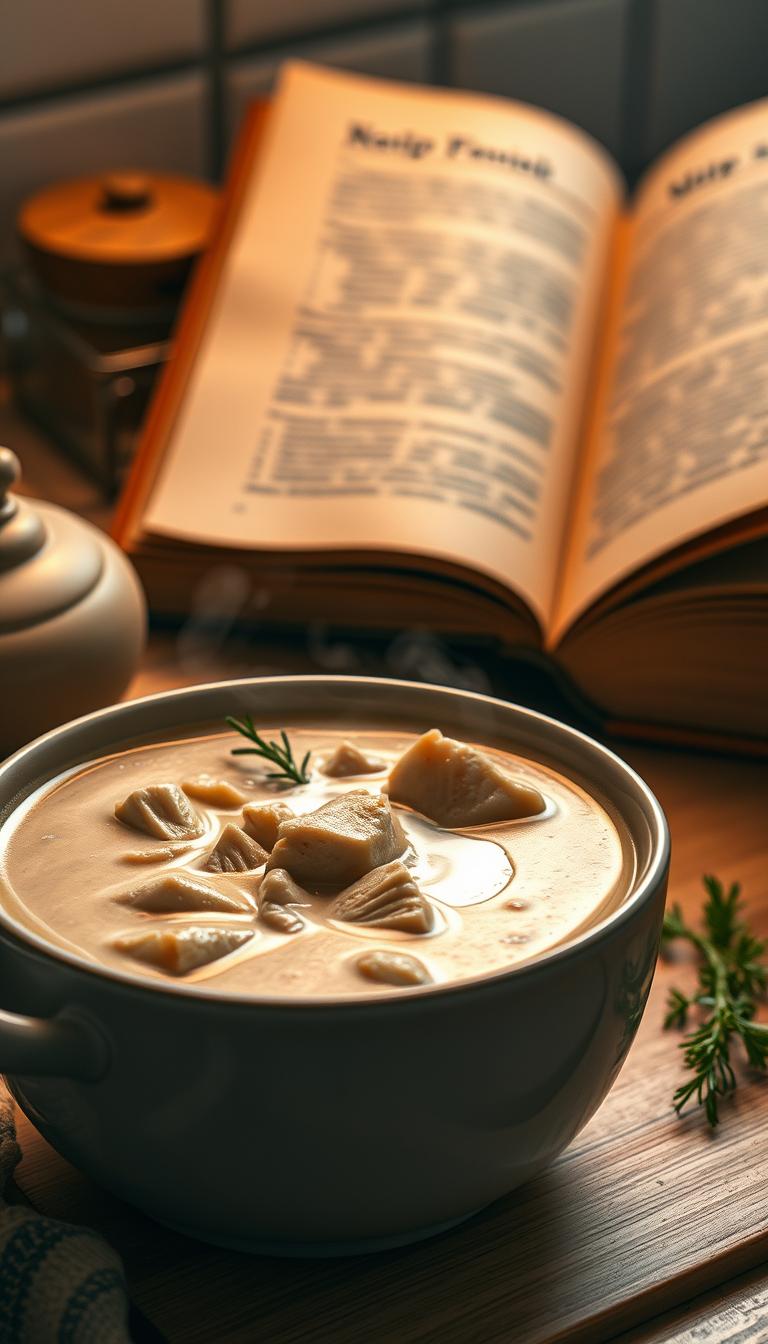Delicious Roast Beef Crock Pot Recipes
Ever pondered how a simple cut of meat turns into a tender delight? The secret to perfect roast beef might just be the crock pot. Easy crock pot roast beef recipes blend convenience with rich flavors. They make the beef juicy and tender, thanks to slow cooking.
This article will guide you through a world of roast beef crock pot recipes. These recipes simplify cooking and enhance family meals. Bid farewell to the hassle of timed roasting. Welcome a stress-free, delicious approach that leaves everyone happy!
Introduction to Roast Beef in the Crock Pot
Preparing roast beef in a crock pot elevates a simple meal into a gourmet delight. This slow cooking method boosts the meat’s flavor and tenderness. It’s perfect for those with busy lives, providing a nutritious meal without the long cooking hours. An easy roast beef recipe can quickly become a staple, thanks to the benefits of slow cooking.
What Makes the Crock Pot Ideal for Roast Beef?
The crock pot is ideal for roast beef due to its low-and-slow cooking. This method allows the meat to soak up flavors over hours, resulting in a tender and flavorful dish. Its hands-off nature is a big plus, allowing cooks to multitask while their meal cooks.
Benefits of Slow Cooking
Slow cooking has several advantages over traditional methods. It preserves nutrients, as the long cooking time breaks down meat fibers, releasing vitamins and minerals. Using cheaper cuts of beef is also wise, as they tenderize well over time. An easy roast beef recipe can be budget-friendly, making it appealing to those watching their expenses.
Essential Ingredients for Roast Beef Recipes
To craft a delectable roast beef dish, it’s critical to choose top-notch ingredients. Identifying the best cuts for roast beef is key to achieving a tender and flavorful outcome. Each cut has distinct qualities that are vital for slow cooking. By pairing these cuts with the right herbs and seasonings, home cooks can take their roast beef recipes to new heights.
Choosing the Right Cut of Beef
The cut you choose greatly impacts your roast’s success. Cuts like chuck roast and rump roast are highly recommended for crock pot cooking. Their fat content melts beautifully during slow cooking, adding a succulent texture. A well-cooked chuck roast becomes incredibly tender, making every bite a delight.
Must-Have Aromatics and Seasonings
Using essential herbs for slow cooking is essential. Aromatics like onions, garlic, and celery are foundational for rich flavors. Seasonings such as Italian seasoning and black pepper boost the dish’s overall taste. Together, these ingredients form a savory base that perfectly complements the roast.
When preparing roast beef, consider pairing the meat with a thoughtful mix of these ingredients. This ensures a captivating meal that will impress both family and friends.
Classic Crock Pot Roast Beef Recipe
A classic roast beef recipe made in the crock pot is not only delicious but also incredibly easy to prepare. This method allows for deep flavors to develop over hours of slow cooking, resulting in tender and juicy meat. The ideal cut for this recipe is a chuck roast, which becomes melt-in-your-mouth perfection when cooked properly. Here’s how to create your own homemade crock pot roast beef.
Step-by-Step Cooking Instructions
- Start by seasoning a 3-4 pound chuck roast with salt, pepper, and your favorite herbs, like rosemary and thyme.
- In a skillet, sear the roast on all sides until browned. This step enhances the flavor.
- Place chopped carrots, potatoes, and onions at the bottom of your crock pot. These will not only add to the meal but also absorb delicious juices.
- Add your seared roast on top of the vegetables.
- Pour in 1 to 2 cups of beef broth to keep the meat moist and flavorful.
- Cover and cook on low for 6-9 hours, depending on your crock pot. Check for doneness as the time approaches.
Recommended Sides to Serve
Complement your homemade crock pot roast beef with some delightful side dishes for roast beef. Consider serving:
- Mashed potatoes, creamy and comforting.
- Fresh garden salad for a refreshing touch.
- Warm dinner rolls to soak up the savory juices.
Variations on Roast Beef Recipes
Exploring different roast beef recipes in a crock pot can transform a classic dish into a culinary adventure. These creative variations turn traditional flavors into exciting meals, appealing to a wide range of tastes. Here are two delightful takes on roast beef that are sure to impress.
Garlic Herb Roast Beef
This version showcases the vibrant flavors of fresh herbs and garlic. The mix of rosemary, thyme, and minced garlic takes the roast to new heights. It’s perfect for those who crave a dish that’s both savory and aromatic. The result is tender beef with a herby essence, pairing beautifully with roasted vegetables.
French Dip Roast Beef
This recipe focuses on the rich, savory essence of the beef. Slow-cooking makes the beef incredibly tender, ideal for sandwiches. Served with au jus for dipping, it’s great for family gatherings. The flavorful broth complements the beef perfectly, creating a satisfying meal.
Timings for Perfectly Cooked Roast Beef
Mastering the cooking times for roast beef is key to achieving tender, flavorful meat. Understanding the nuances of cooking based on size and cut is vital. This knowledge helps any home chef excel in cooking roast beef in the crock pot. Below are essential considerations for the best results.
How Long to Cook Based on Size
The size of your roast beef greatly affects cooking time. A 3-pound roast typically needs 6 to 8 hours on the low setting. Larger cuts, like those weighing 4 to 6 pounds, may require up to 10 hours. It’s important to adhere to these times to achieve the perfect balance of tenderness and flavor.
Adjusting Cooking Time for Different Cuts
Different cuts of beef need adjustments in cooking times. For example, tougher cuts like chuck roast benefit from longer cooking, becoming extra tender. On the other hand, cuts like ribeye can be cooked for a shorter time without losing their juiciness. Knowing these tips can greatly improve your slow-cooking experience. Adjust cooking times based on the specific cut for delicious results every time.
Cooking Tips for the Best Results
To elevate your roast beef experience, certain techniques can significantly improve both flavor and overall presentation. Implementing expert tips for roast beef can make the cooking process more effective while enriching the final dish. Focusing on the preparation of gravy is equally important, as it brings everything together for a delightful meal.
Browning the Meat First
Before placing the roast beef into the crock pot, take time to brown the meat on all sides in a hot skillet. This step creates a rich caramelized crust, contributing deep flavor to the dish. Not only does this enhance taste, but it also improves the overall appearance of the meat. Similar expert tips for roast beef suggest allowing the beef to rest before slicing to retain its juices.
Keeping Gravy in Mind
When preparing your meal, think ahead about making gravy from the crock pot. After the roast beef is finished cooking, drain the drippings into a saucepan. Adjust the seasonings as needed, then consider using a cornstarch slurry if you prefer a thicker consistency. This technique will result in a luscious gravy that complements your roast, ensuring a flavorful dining experience.
Using Leftover Roast Beef
Using leftover roast beef opens up a world of culinary possibilities. It can be transformed into creative and delicious dishes, elevating any meal. This approach not only reduces waste but also maximizes flavor. Leftover roast beef can be shredded for tacos, made into hearty sandwiches, or added to savory soups and stews.
Ideas for Leftover Dishes
- Taco filling with shredded beef, tomatoes, and cheese
- Beef and vegetable stir-fry served over rice
- Classic beef sandwiches with au jus for dipping
- Hearty beef soup with potatoes and vegetables
- Beef hash with potatoes and eggs for breakfast
Freezing Options
If you plan to use leftover roast beef later, freezing it in airtight containers is a great option. Portioning out your leftovers makes thawing and reheating easy. Labeling each container with the date keeps your freezer organized. This ensures you enjoy the benefits of your cooking for months.
Accompaniments That Pair Well
Choosing the right sides for roast beef can transform a simple dish into a memorable feast. The perfect sides not only boost the flavor but also elevate the meal’s presentation. Whether it’s a casual family dinner or a formal event, these pairings will surely delight your guests.
Classic Side Dishes
- Mashed Potatoes: Creamy and buttery, they soak up the savory juices from the roast.
- Green Beans: Crisp and vibrant, they offer a refreshing contrast to the rich roast beef flavors.
- Yorkshire Pudding: A traditional favorite that complements the meat’s texture beautifully.
- Roasted Vegetables: Seasoned carrots, potatoes, and Brussels sprouts enhance the dish’s overall taste.
- Fresh Salad: A simple arugula or spinach salad adds a light, refreshing touch to the meal.
Recommended Wines and Beverages
For wine pairing with roast beef, a full-bodied red is the ideal choice. Here are some options to enhance your dining experience:
| Wine Type | Flavor Profile | Serving Temperature |
|---|---|---|
| Cabernet Sauvignon | Bold with dark fruit flavors | 60-65°F |
| Syrah | Spicy and robust | 60-65°F |
| Malbec | Fruity with soft tannins | 60-65°F |
These beverages perfectly complement roast beef, amplifying its flavors and enriching the meal’s character.
Troubleshooting Common Issues
Slow cooking roast beef can be a hit, but it’s not without its challenges. Tackling roast beef cooking problems is key to a perfect dish. Knowing these issues helps you sidestep mishaps and boost your cooking skills.
Overcooked Roast Beef
Overcooking roast beef often results in dryness and an unpleasant texture. Signs include tough, unpalatable meat. To avoid this, use a meat thermometer to check internal temperatures. They should stay within the recommended range.
Cooking times vary with the beef cut and size. So, you might need to adjust. Aim for a tender, juicy result.
Lack of Flavor Troubleshooting
If your roast beef lacks flavor, it’s time to rethink your seasoning. A good seasoning can make all the difference. Try adding garlic, onions, or herbs to enhance flavor in slow cooker meals.
A splash of soy sauce or Worcestershire sauce can also elevate umami. Taste and adjust seasonings as you go. This ensures a balanced flavor profile.
Healthier Alternatives to Traditional Roast Beef
Families are now more focused on health, leading to a search for healthier roast beef options. These alternatives can upgrade traditional recipes without sacrificing taste. By choosing lean cuts and smart ingredients, we can make lighter roast beef recipes that are guilt-free for all.
Lean Cuts and Healthy Ingredients
Choosing lean cuts like sirloin or eye of round significantly cuts down on fat. These options not only taste great but also fit dietary needs. Adding fresh veggies like carrots, onions, and bell peppers boosts nutrition and flavor. Keeping ingredients simple and natural ensures meals are both tasty and healthy.
Low-Sodium Broth Tips
Low-sodium broth is a smart choice for keeping meals tasty while reducing sodium. This tweak helps families enjoy rich flavors without the high salt found in traditional dishes. For lighter roast beef recipes, try adding herbs like rosemary and thyme to the broth. They add flavor and health benefits without extra calories.
Stories and Traditions Behind Roast Beef
Roast beef holds a special place in American culture, often being the star of family gatherings and celebrations. The warmth of family dinners, where roast beef has been a tradition for generations, fosters deep connections. These moments extend far beyond the meal, symbolizing comfort and unity in many homes.
From Sunday dinners to holiday feasts, roast beef is more than just food. It represents the heart of family togetherness and cherished memories. As families gather, they share stories, pass down traditions, and create lasting memories. These moments strengthen the cultural fabric of the nation, connecting generations through roast beef.
Cultural Significance in American Cuisine
The significance of roast beef in American culture is immense. It’s not just about filling bellies; it’s about family bonds and cherished moments. When families come together for this hearty meal, they create a space for laughter, stories, and love. Over time, these gatherings have woven the nation’s cultural fabric, tying generations together through roast beef.
Family Gatherings and Memories
Every family’s roast beef tradition is unique, reflecting their personal history and taste. Homes often have special recipes passed down through generations, with each adding their own flair. These traditions not only honor the past but also foster a sense of belonging today.
Mealtime becomes a celebration of love, laughter, and shared experiences. Roast beef stands as a symbol of connection within American culture, bringing families closer together.
Conclusion: Enjoying Your Roast Beef Experience
Roast beef crock pot recipes open a world of home cooking, inviting everyone to explore the art of customizable meals. Their beauty lies in flexibility—adjusting seasoning to taste or adding seasonal ingredients opens up endless possibilities. Customizing roast beef recipes lets each meal reflect your unique style and meet your family’s tastes.
At the core of cooking is sharing meals with family. As you try different variations and flavors, you create not just a dish but also memories around the dinner table. Encourage everyone to share their ideas. This collaborative approach can lead to new favorite recipes that your family will eagerly anticipate for years.
Discovering delicious roast beef recipes can become a treasured tradition passed down through generations. The joy of cooking together and the satisfaction of enjoying your creations will strengthen family bonds and create lasting memories. So, roll up your sleeves, get creative, and savor the experience as you share each mouthful with those you love.

